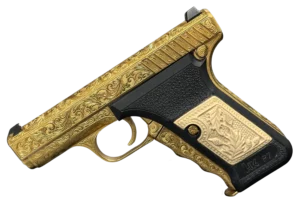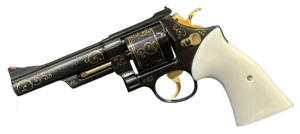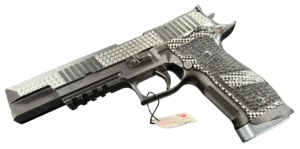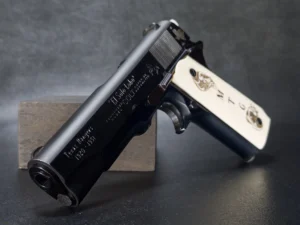Key Takeaways:
- Classic firearms are more than weapons—they’re living artifacts: Each rifle or revolver carries the marks of the era it came from, telling stories of frontier towns, world wars, and cultural revolutions. For collectors, these guns offer a tangible link to the past, where design, conflict, and craftsmanship collide.
- The value of a firearm isn’t just in its firepower—it’s in its legacy: From the no-nonsense reliability of the Mauser 98 to the iconic silhouette of the Thompson SMG, collectors are drawn to firearms not just for their specs, but for the human moments they represent—victory, resistance, invention, and sometimes heartbreak.
- Collecting is about preservation, not possession: When you add a classic firearm to your collection, you’re not just acquiring steel and wood. You’re safeguarding the memory of those who designed it, carried it, and relied on it. It’s about honoring the past, one story (and one trigger pull) at a time.
Some people collect stamps. Others, vintage guitars. But for those of us drawn to the weight of history and the elegance of design, nothing beats a classic firearm. These aren’t just machines built for battle—they’re storytellers. Whether they come from the dust of the Old West or the trenches of World War I, every piece has a tale to tell.
From the thunderous revolvers of cowboys to the engineering marvels of European gunsmiths, these firearms shaped nations, defined eras, and still capture the imagination of collectors everywhere. Let’s walk through ten iconic firearms that don’t just shoot—they echo.
1. The Colt Single Action Army – Where Legends Were Drawn
There’s just something about the Colt SAA. You see one and instantly think of dusty trails, saloons, and gunfights at high noon. Introduced in 1873, it wasn’t just a revolver—it was the six-shooter that won the West.
This .45 caliber powerhouse earned the nickname “Peacemaker” for a reason. Its single-action design meant you had to cock the hammer before each shot—slow by today’s standards, sure, but incredibly reliable and surprisingly accurate. Lawmen, outlaws, and soldiers all trusted it with their lives. Wyatt Earp carried one at the O.K. Corral. Enough said.
Collectors love it not just for its mechanical charm, but because it’s a relic of American grit.
2. Winchester Model 1873 – The Gun That Truly Won the West
If the Colt was the cowboy’s sidearm, the Winchester Model 1873 was his lifeline. Known simply as “the gun that won the West,” this lever-action rifle turned settlers into sharpshooters and outposts into defended forts.
It fired the same .44-40 cartridge as the Colt SAA, a practical convenience on the frontier. With a 14-round tubular magazine and lightning-fast cycling, the Model 1873 brought firepower and reliability together like no rifle before it.
Its place in folklore is sealed. But for collectors, it’s the craftsmanship—the balance, the smooth lever action, the polished wood—that makes it irresistible.
3. Colt 1911 – Built for War, Perfected for Everything
Sometimes a design is just… right. The Colt 1911, brainchild of John Browning, didn’t just change the game—it became the game. Debuting in, you guessed it, 1911, this .45 ACP semi-auto pistol served the U.S. military for over seven decades.
Recoil-operated, built like a tank, and deadly accurate, it became a trusted companion in two World Wars, Korea, and beyond. Soldiers wrote home about it. Enemies feared it. And gun lovers? We still can’t get enough.
Even today, it holds its own against modern polymer pistols. It’s not nostalgia—it’s that the 1911 just feels right in your hand. Clean lines. Solid click. Pure American steel.
4. Springfield Model 1903 – America’s Bolt-Action Backbone
Before the M1 Garand stole the spotlight, the Springfield Model 1903 was America’s soldier’s rifle. And frankly, it still holds up.
Adopted in—you guessed it—1903, this bolt-action .30-06 rifle saw action in both World Wars. It was prized for its precision, and it hit hard. The 1903 wasn’t flashy, but it was dependable, a steady hand in the chaos of the battlefield.
Collectors appreciate the subtle beauty—well-oiled walnut stocks, crisp iron sights, and that smooth, satisfying bolt. Some say it was borrowed a bit too liberally from the German Mauser… but hey, good ideas deserve to spread.
5. AK-47 – The Icon of Resistance
Now, this one might raise eyebrows. But let’s be real: no list of historic firearms is complete without the AK-47.
Mikhail Kalashnikov’s 1947 creation isn’t just a rifle—it’s a symbol. Rugged, simple, nearly indestructible, it’s been the weapon of choice for revolutionaries, freedom fighters, and, yes, some less savory characters.
Its 7.62×39mm rounds pack a punch, and its gas-operated system keeps it running in mud, sand, and snow. Whether in the jungles of Vietnam or the deserts of the Middle East, the AK-47 performs.
Collectors don’t revere it for its elegance. They admire it for what it represents: the raw, unfiltered impact a single weapon can have on global history.
6. Mauser 98 – German Precision on Display
Here’s where design meets discipline. The Mauser 98 is a bolt-action rifle with a pedigree. Introduced in 1898, it became the gold standard of military rifle design—and not just in Germany. Its influence can be seen in countless rifles around the world, including the Springfield 1903.
Its controlled-feed action is still considered one of the best ever made. Built to handle powerful cartridges with grace and reliability, the Mauser 98 didn’t just survive the Great War—it helped define it.
Collectors prize them for their engineering and legacy. And let’s be honest—there’s just something satisfying about that German click-clack of the bolt.
7. Lee-Enfield SMLE – Britain’s Rapid-Fire Hero
If there’s one bolt-action rifle known for speed, it’s the Lee-Enfield. Especially the SMLE Mk III, introduced in 1907. Soldiers could rattle off up to 20 aimed shots per minute—a feat dubbed the “Mad Minute.”
Chambered in .303 British, the Lee-Enfield was accurate, durable, and most of all, fast. It carried the British Empire through both World Wars and countless conflicts beyond.
Even today, surplus Enfields are favorites at the range. Smooth cycling, long sight radius, and a whole lot of history packed into every round.
8. M1 Garand – Patton’s Favorite
General Patton didn’t mince words. He called the M1 Garand “the greatest battle implement ever devised.” And he wasn’t wrong.
Issued in the 1930s, the M1 was America’s first semi-automatic standard-issue rifle. Firing .30-06 from an 8-round en-bloc clip, it let U.S. troops outgun their bolt-action-toting enemies in WWII and Korea.
The distinctive “ping” when the clip ejects? Music to a collector’s ears. Rugged, reliable, and flat-out beautiful in walnut and steel—the Garand is more than a rifle. It’s an anthem.
9. Thompson Submachine Gun – The Roaring Gun of the ’20s
The Thompson SMG—or Tommy Gun, as everyone knows it—has a split personality. One part hero, one part outlaw.
It roared through the Prohibition era, with gangsters on one side and federal agents on the other. Later, it cleaned up its act and served bravely in WWII, favored for its close-quarters stopping power thanks to its .45 ACP punch.
Iconic doesn’t even begin to cover it. That drum mag. The foregrip. The unmistakable chatter when it fired. For collectors, the Thompson isn’t just cool—it’s a cultural flashpoint wrapped in steel.
10. Swiss K31 – Precision from the Alps
The Swiss weren’t out conquering empires—but that doesn’t mean they didn’t make brilliant rifles. The K31 is a perfect example.
Straight-pull bolt, 7.5×55mm Swiss cartridge, tight tolerances—it’s basically a Rolex that fires bullets. Issued starting in the 1930s, it was used well into the Cold War era, and thanks to Switzerland’s obsession with maintenance, most surplus K31s today are in fantastic shape.
Collectors swoon over the smooth action and laser-like accuracy. It’s a rifle you don’t just shoot—you appreciate it.
More Than Metal: The Legacy We Hold
See, these firearms aren’t just tools. They’re time machines. They bring history alive—smoke, noise, tension and all. You hold one, and suddenly you’re not just at the range—you’re in a foxhole, a frontier town, or a rain-soaked jungle.
Each of these classics carries its own emotional fingerprint. The Colt 1911 isn’t just a sidearm—it’s a war buddy. The Winchester 1873 isn’t just a rifle—it’s the spine of westward expansion. Even the AK-47, rough around the edges, tells a story of struggle and resilience.
As collectors, we’re not just preserving steel and wood. We’re curating moments in time.
The Collector’s Role in History
It’s easy to get caught up in specs—caliber, rate of fire, and action types. But real collectors? We chase the stories. We feel the weight of sacrifice, courage, and innovation.
Every classic firearm is a reminder of who we were, what we endured, and how we evolved. Whether you’re polishing a Garand or displaying a K31, you’re keeping history alive. And honestly, there’s no better way to connect with the past.
Thanks for joining me on this walk through history’s arsenal. If you’re new to collecting, maybe this lit a spark. And if you’re already knee-deep in walnut stocks and blued barrels—well, you know exactly what I’m talking about.
Frequently Asked Questions
Great question. There is no one-size-fits-all definition, but most collectors consider a firearm “classic” based on a combination of historical impact, design significance, rarity, and cultural legacy. If a gun helped shape a chapter of history or represents a significant leap in firearm design, it likely meets the criteria.
Not necessarily. Age alone doesn’t guarantee worth. Condition, provenance (who owned it or where it was used), production numbers, and mechanical integrity all play a role. A pristine K31 with matching serials might fetch more than a beat-up surplus rifle from the same era—context matters.
In many countries, including the U.S., yes, with certain restrictions. Some firearms might be classified under local laws as antiques, while others may require special licensing (like an FFL or C&R license). Always check your local and federal laws before making a purchase. Better safe than sorry.
You’ve got options. Reputable dealers, auctions, estate sales, collector forums, and even old-school gun shows are all solid places to look. Online platforms like Rock Island Auction Company or GunBroker offer verified listings, but be sure to do your homework. Documentation and condition reports are your friends.
Start with something you’re genuinely fascinated by—maybe a piece with a story you connect with. Focus on condition, matching parts, and originality. Don’t chase rarity for rarity’s sake. And talk to other collectors—they’re often walking encyclopedias willing to share hard-won insights.












